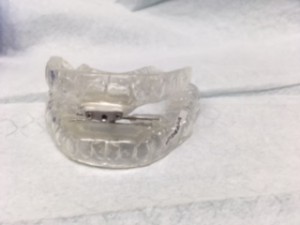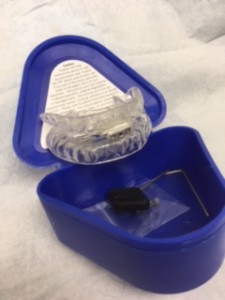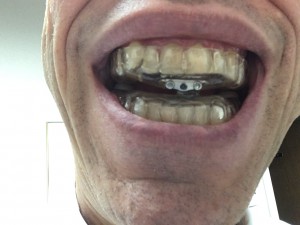Mandibular Advancement Device
Some obstructive sleep apnea sufferers are looking for a non-invasive (non-surgical) solution to control their sleep apnea symptoms and heavy snoring. Often, they are told to use CPAP (continuous positive airway pressure, also known as the “sleep mask” or “sleep machine”). But not everyone who needs treatment for sleep apnea can tolerate CPAP, or is willing to strap a mask to their face in order to get a good night’s sleep.
There is another solution. An oral appliance, known as a mandibular advancement device, can often help. It is a device that you put in your mouth before going to sleep, and you wear it all night long, like a retainer. It is custom-molded to fit on your upper and lower teeth, with an adjustable connector between the two parts. You can fine-tune the setting of the device until your snoring and sleep apnea reduces to an acceptable level. You can see an example of what one appliance looks like by checking the photos below. (There are other options that have a slightly different appearance).
Dr. Spingarn at Westchester ENT is now making these devices for sleep apnea sufferers. After an appropriate diagnostic evaluation and sleep testing has been performed, Dr. Spingarn will let you know if you are a good candidate for a mandibular advancement device. If so, he will take impressions of your teeth, which will be sent to a device-making laboratory, and then you will come back to the office to receive your device. If you live far away from the office, we are now offering a remote treatment option, where you take your own dental impressions with a kit and receive your appliance in the mail.* In many cases, your health insurance coverage will pay for all or most of the cost of your treatment. If you have Cigna, United Healthcare, Oxford, or The Empire Plan, you likely have full coverage for this. With other commercial insurances, such as Aetna, you may have partial coverage. Blue Cross offers partial coverage if you have out-of-network benefits. Government-sponsored plans, such as Medicare and Medicaid, and union plans, such as Local 1199, do not offer coverage, but we do offer a self-pay option.
In order to use a mandibular advancement device, your teeth should be in good shape, with no dental decay or active dental problems. You also should have no history of jaw pain or the jaw-joint disorder known as temporomandibular dysfunction (often abbreviated as TMJ pain or TMD).
If you are coming to the office for an oral appliance consultation, you can save yourself time and energy by preparing in advance. For instance, if you already have a diagnosis of obstructive sleep apnea, then try to bring a copy of your sleep test results with you. It’s best if the sleep test was performed less than one year ago, or else you might need us to order you a new test. If you do not have a diagnosis yet, call our office before your visit so we can arrange for a sleep test to be authorized by your insurance company. Sometimes, we can arrange for you to have the test performed on the same day that you come for your consultation.
*If you want an oral appliance but live far away and cannot come to the office for an in-person consultation, you have a remote option. This option applies to patients insured by Cigna, Oxford, United Healthcare, and Empire Plan, as well as private-pay patients. You can potentially obtain an appliance by taking your own dental impressions (with a kit that we send to you) and receiving your appliance via a delivery service. If this interests you, you are welcome to start the process by requesting a telehealth consultation with Dr. Spingarn.




